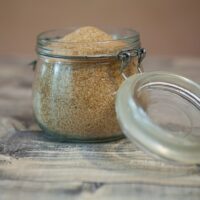Uncovering the Hidden Sweetness in Everyday Foods
(The following article was written for the December 2020 issue of Get Healthy magazine, a publication of The Northwest Indiana Times. I’m sharing my article now because I had a reader request information on added sugars in foods you’d least suspect and this article covers it.)
While health experts may not agree on every aspect of nutrition and diet, the one thing they do agree on is that limiting intake of foods with added sugar is beneficial for everyone. Added sugars are sugars and syrups that are added to foods or beverages when they are processed or prepared. As I refer to sugar throughout this article, I’m not referring to naturally occurring sugars such as those in fruit or milk. 
The average American consumes approximately 17 teaspoons of sugar per day. The American Heart Association states that the maximum amount of added sugar in your day be 37.5 grams or 9 teaspoons for men and 25 grams or 6 teaspoons for women. Kids between the ages of 2 and 18 should have less than 25 grams daily for heart health. To put this amount in perspective, there are 39 grams of sugar in a 12-ounce can of Coca-Cola with no nutritional redemption.
The Downside of Added Sugar
It tastes so good and experts agree that sugar may be as addictive as cocaine. Excessive sugar consumption is associated with a variety of health problems including type 2 diabetes, heart disease, obesity, cancer, high blood pressure, and cognitive disorders, such as dementia or Alzheimer’s disease. It disturbs the balance of bacteria in the gut, leading to inflammation and a weakened immune system.
Where Sugar Hides Out
Many of the foods and beverages where you are getting sugar are easy to identify: soft drinks, candy, cookies, assorted baked goods, sweetened drinks and frozen dairy desserts. Organic and “natural” foods are not exempt, so don’t be fooled. Organic sugar is still sugar.
There’s a long list of what might be considered as “healthy” foods that contain high amounts of sugar: cold and instant hot cereals, breads, granola and protein bars, meal replacements; “lower calorie” drinks including energy drinks, coffees and teas; condiments like ketchup, barbecue and tomato sauce, and bottled dressings; sweetened yogurts and kefir; frozen pancakes and waffles. Beware of foods marketed as “light” or “low fat” as those often contain higher amounts of sugar than what you’d find in the regular varieties.
Ways to Cut Back
While some people find that it’s easier to completely cut out sugar-laden foods and go “cold-turkey,” others do well to cut back slowly. The first step is being aware of what’s in your food, especially if it comes with a label. Check out how many grams of sugar are in a serving and decide if it’s worth it. Would you rather have a sugary drink or an amazing homemade chocolate chip cookie?
There are companies that make sauces, dressings and condiments without the high sugar content. While they may taste strange at first, you can train your taste buds to enjoy the true flavor of foods. If you’re a yogurt fan, try buying the plain, Greek variety and add a small amount of raw honey or fresh fruit for sweetness. Although honey is a sweetener, you’ll probably end up adding much less than the amount you’d find in the flavored varieties, and over time, you’ll be able to get away with only the fruit. Be patient with yourself during this process.
If you enjoy baking, it is possible to reduce the amount of sugar that the recipe calls for, and still produce a delicious product. You can reduce the amount of sugar in a cake recipe by 10%. Remove 5 teaspoons from each cup of sugar called for in the recipe. I’ve done this and found it to be successful. One that I’ve not tried is substituting unsweetened applesauce. It has a one-to-one ratio with sugar, so begin by swapping out up to half the amount. This allows for the best browning and texture. Experiment and adjust accordingly, as this may work best in quick breads, muffins, and cookies, rather than a traditional layer cake. Seek out recipes that call for lower amounts of sweeteners. Stevia is another possible substitute worthy of experimentation. 
I briefly mentioned naturally occurring sugars found in fruit and starchy vegetables. These foods offer nutrients, fiber, and protection from many of the same diseases that added sugar contributes to and are metabolized differently. For those of you wondering about artificial sweeteners, it’s best to avoid them. They are addictive and create health concerns as well.
As you practice limiting your sugar intake, it may seem like a huge challenge. Bringing the intention of consuming less sugar into your consciousness will help more than you think.
Much love,
Health Coach Carol
America ships tons of sugar cookies to Denmark and Denmark ships tons of sugar cookies to America. Wouldn’t it be more efficient just to swap recipes?—Michael Pollan


